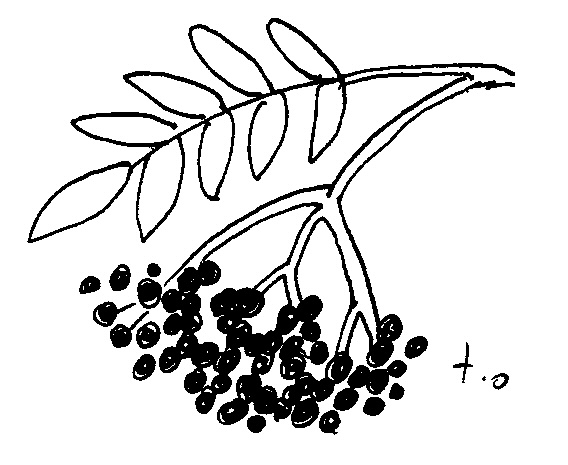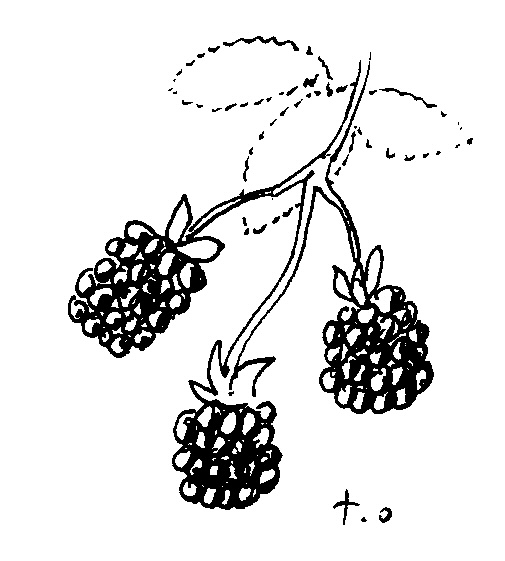By Roberta Bailey
Blackberries are the cruel temptresses of the berry kingdom. They promise sweetness yet they can make you bleed. The berries are so delicate. The thorns leave scars. There are always stories to tell, clothes to be mended. And yet, the berries can be divinely sweet and delicately flavored. The promise of more perfectly ripe berries can lure you deeper into the patch, your fingers seeking their heavy, soft coolness. But picked just the slightest bit under-ripe, they jolt you with acidity.
I remember learning the timing of the ripening berries. Actually, I think I have to relearn it every year. Never eat the berries with a reddish-purple hue. They are so sour it seems that they will take the enamel off your teeth and give you an ulcer. Sometimes the purple ones look ripe but are still too acidic. And finally, you pick that first plump, soft, fully juicy, delicate ripe berry and put it in your mouth. Sweet blackberry heaven. No blackberry in a plastic clamshell on a supermarket shelf comes close to this perfection. You forgive all the blood and hardship.
The other thing about wild blackberries is how their flavor changes so dramatically when they are cooked. They develop a unique spiciness, somewhat like a hint of allspice. They make amazing tarts and jam and juice, cordials, and syrups. Seeds can be removed by running the cooked berries through a sieve, strainer, or mill.
Every place I have lived, there have been blackberries growing wild. I know of two types in Maine, the more common 4-to-7-foot-tall variety and the lesser-known delicate short canes that are only a few feet tall and arch to the ground. The smaller canes have smaller berries but can be very prolific, with far less drama.
I am confused by the lack of availability of hardy blackberries in catalogs. I guess you’ve got them or you don’t. I have known of great patches in Aroostook, Penobscot, and Washington counties. There are at least 10 patches on my mile-long road in Central Maine. You can scout patches easily by their white blooms in early June.
The aggressive canes can be a challenge to prune. I psyche myself up for the task, donning heavy canvas clothes and wielding my longest loppers. And I strategize ways to dispose of the thorny canes that involve not touching them at all. Those thorns can pierce leather work gloves.
If you pick an unpruned patch, try the strategy where you step on last year’s dead fruiting canes as you navigate the patch. The canes may snap, or at least stay low to the ground while you pick. Canvas gardening sleeves can be helpful. Long sleeves and long pants are a necessity. Leather is the safest option.
Like other berries, blackberries can be frozen. I think they gravitate back toward acidity when frozen, but if cooked, they behave sweetly and deliver their full spicy flavor. I tend to just fill gallon freezer bags. The berries clump slightly but come apart if bumped on the counter. (Most of my blackberries get used for blackberry-elderberry juice. I freeze the elderberries earlier, then blackberries as they ripen, saving them all for a fall day when I want the heat in the house and have more time for canning projects.) One can also freeze them on baking sheets, then fill containers or bags.
Suit up, blaze some trails, bravely pick some blackberries. They are worth it. Blackberries can be substituted for most berries in pie or crisp. Try a peach-blackberry pie, blackberry muffins or scones, or blackberry crisp. Here is a collection of recipes that I make every year in celebration of the blackberry’s delicate flavor.
Blackberry-Elderberry Juice

(This lightly sweetened juice sustains me through the winter. I drink it daily if I feel a cold trying to set into my body.)
1 part blackberries
1 part elderberries
Water
Honey to taste
Fill a large pot with the berries. Add enough water to cover 4-6 inches above the level of the berries in the pot.
Bring to a low boil, then simmer for 10-15 minutes. Mash the berries by hand or with an immersion blender. Be very careful not to spray yourself with boiling juice.
Scoop the berries out with a strainer and press the juice out of each scoopful. Repeat until most berries are removed.
Sweeten to taste with honey. (Start with ½ cup per gallon.)
Juice can be frozen or canned. To freeze, fill pint-sized wide-mouth mason jars or any container that will hold liquid and not break in a freezer. Leave 1 inch of headspace. Seal the jar or container. Place in the freezer. Use within two years.
To can, fill sterilized pint or quart canning jars, leaving ½ inch headspace. Seal. Process for 25 minutes in a boiling water bath.
No Sugar Blackberry Jam (Made with Low Methoxyl Pectin)
Cook and puree the blackberries. If fewer seeds are desired, run the puree through a sieve.
Measure your puree. Return it to heat, and bring to a low boil.
For each cup of puree, measure out ⅛ cup honey and ½ teaspoon low methoxyl pectin. Mix them together thoroughly. Stir the mixture into the jam puree.
Now add 1 teaspoon of calcium solution for each cup of puree. The calcium comes in a separate small packet. To make the solution, mix ⅛ teaspoon calcium powder with ¼ cup water.
Stir well. To check the thickness, take a teaspoon of jam and cool it in the freezer or even at room temperature. Once cool, if too thin, add more calcium solution.
Fill sterile canning jars with jam, leaving ½ inch of headspace. Wipe the rim, then place the lid and seal lightly. Boiling water bath the jars for 5 minutes. Remove the jars, and arrange them to cool on a rack or countertop. Check the seal before storing.
Blackberry Cream Cheese Tart

Tart dough:
1 cup all-purpose white flour
1 Tbsp. sugar
¼ tsp. grated orange peel/zest
8 Tbsp. chilled butter, cut into thin slices
1 Tbsp. water mixed with ½ tsp. vanilla extract
Combine the flour, sugar, and orange zest in a bowl. Cut in the butter; then add the vanilla water.
Use your hands to press the dough into a 9-inch tart pan.
Bake at 400 F for 5-7 minutes. Remove from oven and cool before filling.
Filling:
8 ounces cream cheese, room temperature
¼ cup sour cream
Grated peel of 1 small lemon
1 Tbsp. honey
Nutmeg
3 ¼ cups blackberries
¼ cup honey
Put ¾ cup blackberries in a saucepan and heat them. Reduce to half the volume. Stir in the honey.
Beat together the cream cheese, sour cream, lemon peel, and honey. Add a sprinkle of nutmeg.
Spread the mixture on the cooled tart dough. Spread the reduced blackberry puree on the cream cheese in the tart pan.
Arrange the blackberries on the puree. Chill for half an hour. Serve.
Peach-Blackberry Sauce

7-8 peaches, peeled by dipping for one minute in boiling water, then slipping off the skins
3 cups blackberries
1 cup sugar or ½ cup honey
1 cup apple juice or water
2 Tbsp. lemon juice
1 tsp. lemon zest
¼ tsp. almond extract or 1 Tbsp. hazelnut liquor (optional)
Combine all ingredients except honey or liquor if using. Bring to a boil and reduce heat, simmering for 20 minutes or until the fruit is soft and liquid has thickened. Add honey and liquor, if using.
To can: Sterilize ½ pint or pint jars; fill, leaving ½ inch headspace. Seal jars and process for 10 minutes in a boiling water bath.
Blackberry-Orange Slump
4 cups fresh or 2 lbs. frozen blackberries
¾ cup sugar
½ cup orange juice
1 cup white flour
⅛ tsp. salt
1 tsp. baking powder
½ tsp. baking soda
¼ tsp. nutmeg or allspice
1 Tbsp. orange zest
2 Tbsp. melted butter
½ cup buttermilk (or ¼ cup yogurt mixed with ¼ cup water)
Topping:
1 Tbsp. sugar
¼ tsp. ground cinnamon
Pinch of nutmeg
Pinch of ground black pepper
Mix topping ingredients together and set aside.
Combine the berries, sugar, and juice in a bowl and set aside.
Mix together the flour, salt, baking powder, baking soda, and nutmeg or allspice. Very lightly stir in the buttermilk, zest, and melted butter. Too much stirring will make the dumplings tough.
Place the blackberry mixture in a heavy, non-reactive 8-to-10-inch skillet or pan. Bring to a boil and reduce the heat to a simmer. Drop large spoonfuls of the batter onto the simmering berries, until all the batter is used. Sprinkle the batter with the topping.
Cover tightly and simmer for 20 minutes. The dumplings are puffed and should feel dry to the touch, but not browned. Leave the lid on to avoid deflating the dumplings.
Cool with lid removed for 15 minutes before serving. Whipped cream or ice cream are great additions.
This article was originally published in the fall 2024 issue of The Maine Organic Farmer & Gardener. Want more seasonal recipe inspiration? Sign up for our monthly local and organic kitchen emails.
